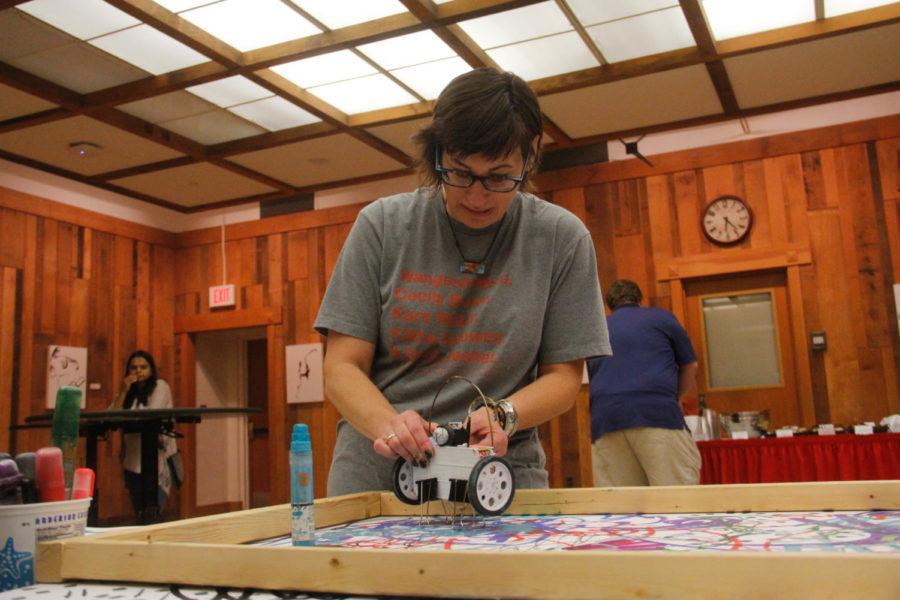Amenda Tate and her dance-painting robot
Des Moines artist Amenda Tate working with Manibus, a robotic painting device during her open gallery at the MU on Aug. 30. Tate created Manibus to capture and translate movement into painted works of art. A dancer wears a motion-sensing remote that prompts the robot to render a depiction of elapsed time and motion. The works take shape as dynamic linear renderings in acrylic on paper.
August 30, 2018
Humans have created art since the dawn of our existence. Archaeologists have found artifacts dating back thousands of years before the modern homo sapien ever walked the earth. Has artist Amenda Tate handed art over to the robots with the Manibus? Not really.
Tate, Des Moines, Iowa, native, attended Iowa State where she started studying mechanical engineering. After completing half of the program, she decided to pursue her career in art. Tate graduated from Metropolitan State University of Denver with a bachelor’s degree in fine arts with emphasis on metalsmithing and jewelry design.
Tate bridges the gap between art in motion and static art with the Manibus robot. The artist’s invention uses a cell phone in an exercise armband to capture a dancer’s movement which is sent over Bluetooth connection to the Manibus. From there, the dancer’s routine is converted into brush strokes on paper.
The Manibus was inspired by a “transformative” experience Tate had while attending a ballet.
“It was just one of those moments where all of a sudden I got it,” she said. “It is about not just the people, and the bodies, and the positions, but it’s about the energy of what they’re doing and how they’re emoting that, and how can you capture that essence.”
The Manibus is the culmination of all of Tate’s schooling and then some.
“I don’t know if I can quantify how much of this or that or the other, because I feel like it’s all in the same pot for me,” she said. “It’s all in the soup.”
For the robot, she had to learn about programming and electronics, something that is still an ongoing process for her. As problems would present themselves, Tate had to create mechanical parts to make everything work together.
“It was just a matter of ‘what solution do I need?’,” Tate said.
While there have been setbacks in the creative process and various repairs and modifications made to the robot, Tate said this is still the first iteration of the Manibus.
“I’m not going to call this version two yet, because my version two is going to be one that has some different functionality than this one has,” Tate said.
Increasing the robot’s speed is one of the planned features Tate has in mind for the eventual Manibus 2.0.
“It could cover more ground and still create the same response to the movement but just in a different scale,” Tate said.
She also mentioned she’d like to incorporate a recording function into the Manibus so she would be able to play back dancers’ movements, allowing her to add a new dimension to the paintings.
Tate doesn’t feel like the finished paintings can be attributed to any one artist. The final piece is part of a collaborative effort. This, she said, makes it appeal to a broader audience, even to those who might not otherwise be interested in the painted art form.
“When people say, ‘what is your medium?’: It’s not just the robot, it’s not just the painting, it’s not just the process,” Tate said. “I feel like all of that is my medium. I don’t feel like any one part of it independently tells the whole story.”
In 2017, Tate used the Manibus to work with Ballet Des Moines on their production of “Snow White,” where she spent time on the sidelines during rehearsals trying to “crack” what was happening. Her first time using the Manibus in the field, she found it challenging to integrate herself into rehearsals without being intrusive.
“I had just figured out that the robot would do something, and it kind of did something cool, but I didn’t really know how any of it was going to go,” Tate said. “We were all taking these steps of vulnerability to just go for it together.”
The experience, she said, “Blew any expectations I had totally out of the water.”
Since then Tate has worked with the Colorado Ballet, where she was granted with more creative control, and armed with more knowledge about how to properly utilize the Manibus. In the future she hopes to work with other dance forms, like the tango. She is currently looking for a hiplet company to work with, the mixture of hip hop and ballet dance forms intrigues her.
Tate encourages students to try things that interest them, even if it means taking a risk or doing something they normally wouldn’t think about.
“You don’t know if you don’t try,” Tate said. “Everyone is so worried about failing, so we don’t try the things that we might be really amazing at.”







